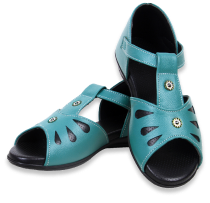A Step Towards Better Diabetic Health
The Diabetic Foot: Understanding the Risks

Diabetic Footwear: More Than Just Shoes
Diabetic footwear isn’t just about comfort; it’s a medical necessity for many. These specially designed shoes help in:
- Reducing Pressure Points: They distribute weight evenly, reducing pressure on any one part of the foot.
- Minimizing Impact and Shear Forces: The cushioning in diabetic shoes absorbs impact and reduces shear forces that can cause skin breakdown.
- Accommodating Foot Deformities: They have extra depth and width to accommodate foot deformities common in diabetics, like hammertoes and bunions.
Material Matters: The Science Behind Diabetic Shoe Design
The materials used in diabetic footwear are crucial. They are typically made with soft, non-binding uppers and seamless interiors to prevent irritation. The insoles are usually made of materials that conform to the foot, providing support and reducing the risk of pressure sores.
The Role of Orthotics in Diabetic Footwear
Custom orthotics play a vital role in diabetic footwear. They are tailored to the individual’s foot contours, providing additional support, distributing pressure evenly, and preventing complications.
Choosing the Right Diabetic Footwear: A Guide
Selecting the right diabetic shoes is paramount. This includes:
- Professional Fitting: Getting professionally measured and fitted for diabetic shoes is essential.
- Prioritizing Function Over Fashion: While aesthetics are important, the primary focus should be on protection and comfort.
- Regular Replacement: Diabetic shoes should be replaced regularly to ensure ongoing foot protection.
Insurance and Cost Considerations
It’s important to note that many insurance plans, including Medicare, cover diabetic footwear if prescribed by a doctor. Understanding insurance coverage can make these essential items more accessible.
Lifestyle and Foot Care: Complementing Diabetic Footwear
While diabetic footwear is crucial, it’s part of a larger foot care regimen. Regular foot examinations, maintaining good hygiene, controlling blood sugar levels, and avoiding walking barefoot are equally important.
Conclusion: A Step in the Right Direction
Investing in diabetic footwear is not just about foot care; it’s about enhancing overall health and well-being. By understanding the importance of these specialized shoes, individuals with diabetes can take a proactive step in managing their condition, preventing complications, and leading a more comfortable and active life.
In conclusion, diabetic footwear is an essential aspect of diabetes management. Its importance cannot be overstated, and its role in preventing serious complications is invaluable. Through education, proper selection, and use, diabetic footwear can significantly contribute to the health and quality of life for those living with diabetes.







